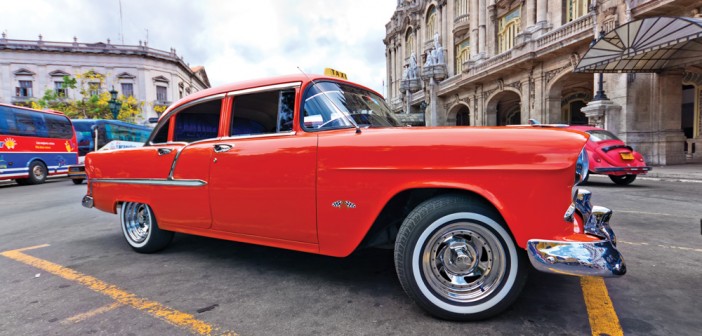In 2014, the Obama Administration announced plans to reinstate diplomatic relations with Cuba. President Obama then visited to Cuba in March 2016, which was the first visit of an American president to the island nation since Calvin Coolidge did so in 1928. The normalization of diplomatic relations and presidential visit come at a time when Raul Castro, the president of Cuba, is looking to liberalize the country’s stagnant economy.
Taking a trip to Cuba is like taking a trip back in time, especially when it comes to automobiles. Cubans drive vintage 1950s Chevys and Fords as their daily vehicles. In fact, there are approximately 60,000 American cars in use in Cuba and the average age of these vehicles is over 60 years. Many blame this on the U.S. trade embargo, which has been in place since 1960. The embargo is not responsible for the age of cars in Cuba, as the embargo only applies to trade between the U.S. and Cuba and other countries freely trade with Cuba. The reason why Cubans drive old cars is that the country has banned the import of automobiles since 1959. One of Raul Castro’s economic reforms is to lift this ban.
This has companies like General Motors eager for the U.S. government to lift the Cuban embargo, which would allow GM to enter the Cuban market and meet 60 years of pent-up auto demand, especially in light of the decline in market share that GM has experienced. In 1961, the company had a 45 percent market share in the U.S., meaning they were responsible for 45 percent of all new vehicle sales. By 2015, GM’s market share had fallen to just over 17 percent, a decline that has continued even after its bankruptcy and reorganization. The bankruptcy simply allowed the company to shed its legacy costs, allowing it to be profitable at a lower market share.
One point of market share represents approximately 180,000 vehicle sales per year. Thus, losing 28 points of market share over a 54-year time period is the equivalent of losing about five million vehicle sales per year. To put this in perspective, the assembly plant in Lansing Delta Township produces about 280,000 vehicles per year. Thus, losing five million sales means that 17 Lansing-sized assembly facilities are no longer needed. No wonder so many plants have closed!
Emerging markets have been a bright spot for the company. GM has made inroads into the Chinese market, particularly with its Buick brand. It was due solely to Chinese sales that Buick was not eliminated during the government takeover of General Motors during the financial crisis, when other brands such as Pontiac and Saturn were eliminated.
Cuba is a poor country; however, the Chinese experience shows that if a communist economy begins to liberalize, it can rapidly grow. Given its proximity to the U.S., Cuba could be poised for rapid growth. This would allow for American tourism into Cuba and exporting Cuban-made goods into the U.S. market at low cost. Average income per person in Cuba is approximately the same as it is in China, which means that auto sales will likely be strong once the import ban is finally lifted. A caveat: Cuba is a small country. Its population is about the same as that of Michigan, so the Cuban market will not solve all of GM’s market share problems. However, the ability to sell cars to a market of 11 million consumers who have not bought a new car in 60 years should bring the company a nice burst of revenue.














